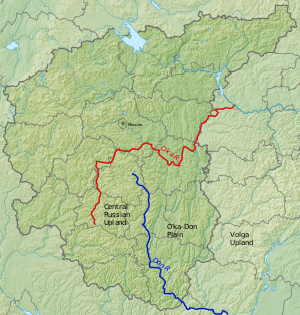Volga Upland
The Volga Upland, also known as the Volga Uplands, Volga Plateau, Volga Hills,[1] or Volga Plateau, (Russian: Приволжская возвышенность - Privolzhskaya vozvyshennost) is a vast region of East European Plain in European part of Russia that lies west of the Volga River and east of the Central Russian Upland. The uplands run for approximately 800 kilometres (500 mi) in a southwest-northeasterly direction from Volgograd to Kazan. The Tsimlyansk Reservoir lies at the southwestern end of the Volga Upland, with the Kuybyshev Reservoir at the northeastern end.

The landscape on the Volga Uplands is hilly, and several rivers has cut into it, such as the Khopyor, Medveditsa and the Sura. The Volga-Don Canal cuts through the lowlands between the Volga Uplands to the north and the adjacent Yergeni Hills to the south.
The uplands lie in the cool continental climate zone, characterised by large fluctuations in seasonal temperatures and generally little rainfall. Outside of the cities in the region, population density is generally between 28 and 129 inhabitants per square mile.
The Volga Uplands themselves is rather sparsely populated, but along its edges and in particular along the banks of the Volga there are several large cities, such as (from north to south) Kazan, Ulyanovsk, Saransk, Penza, Syzran, Saratov and Volgograd.
"Mountains"
The rocky hills along the Volga banks are traditionally called mountains (Russian: горы), despite of low height. From
- Uslon Mountains
- Yuryevy Mountains
- Bogorodskye Mountains
- Syukeyevo Mountains
- Tetyushi Mountains
- Undory Mountains
- Zhiguli Mountains
- Khvalynsk Mountains
See also
References
- DK Publishing (1999). Millennium World Atlas. DK. p. xxix, 229. ISBN 978-0-7894-4604-6